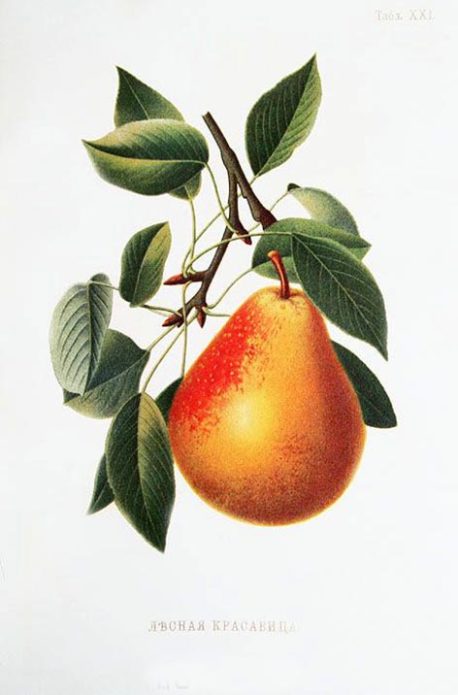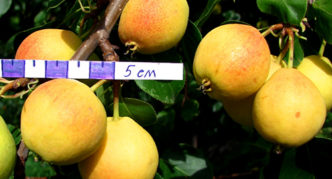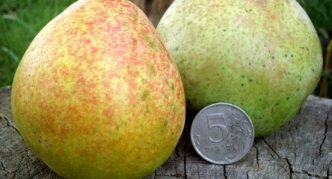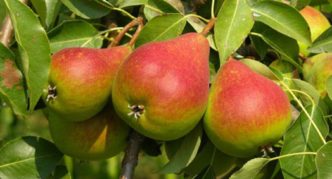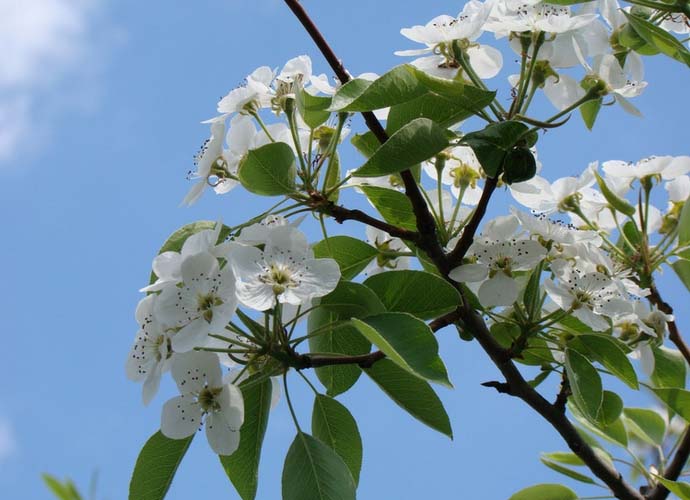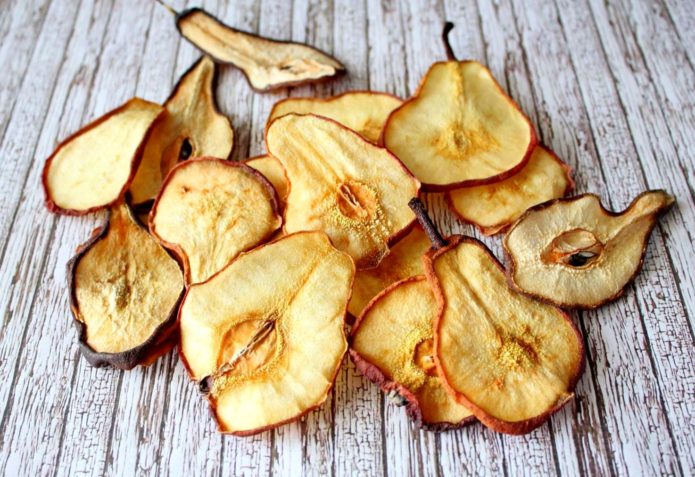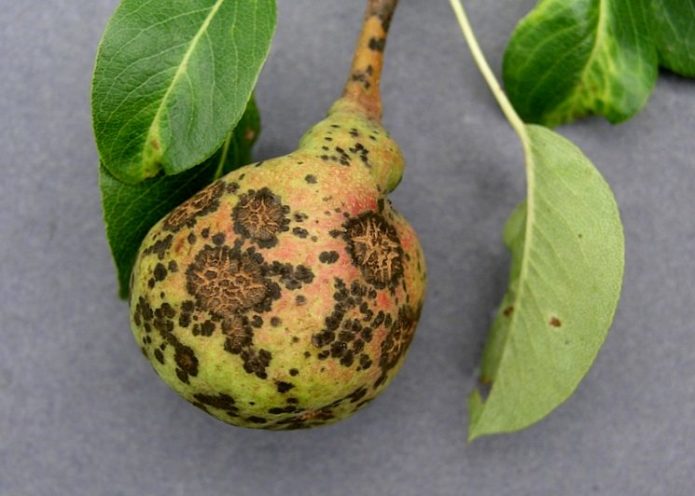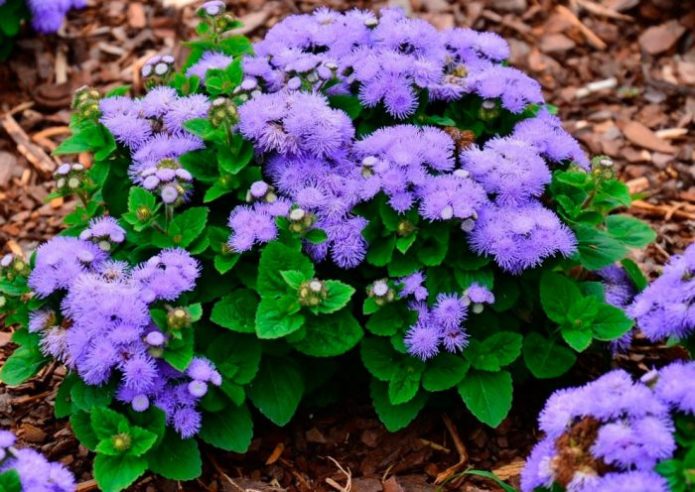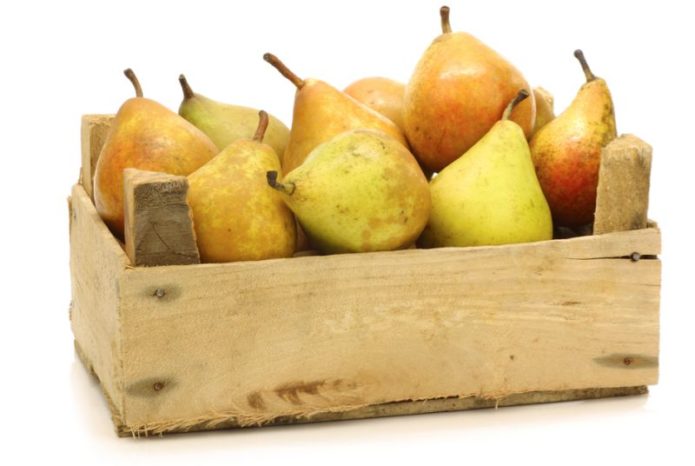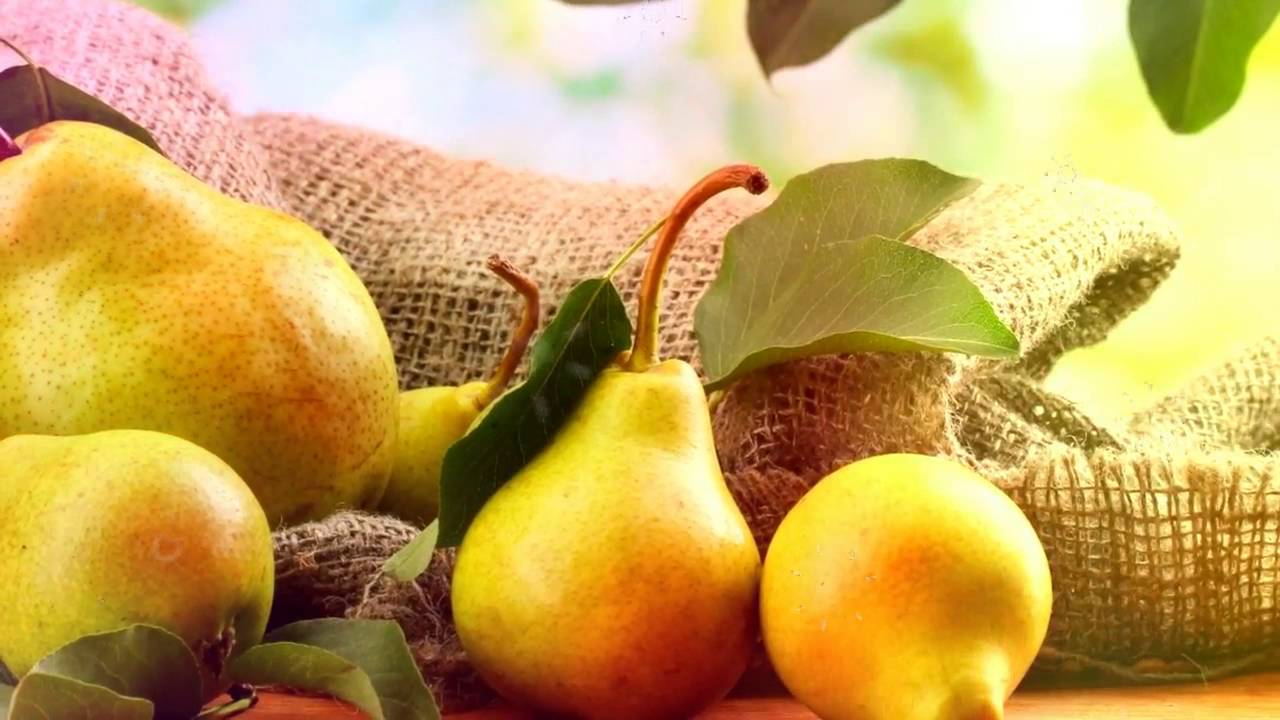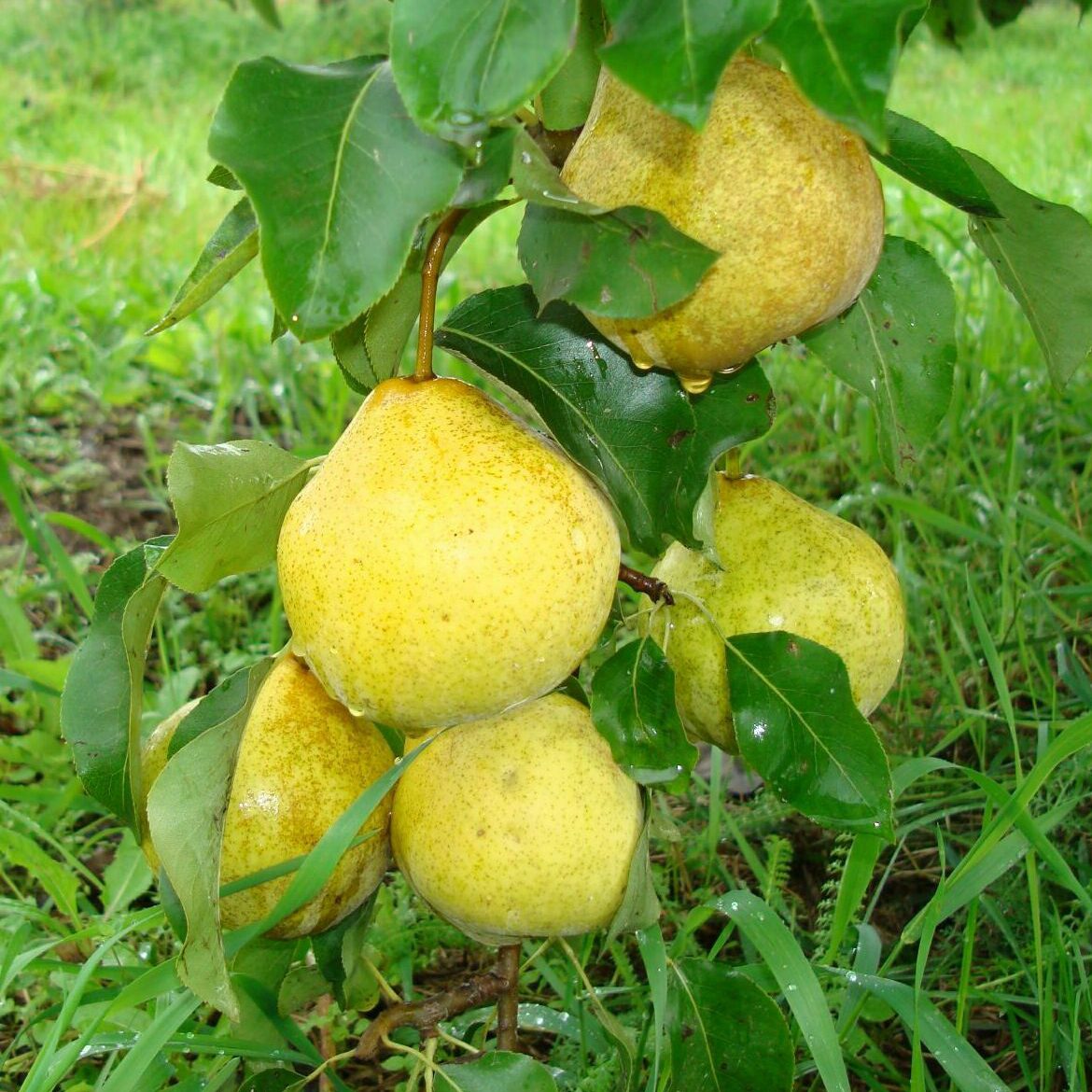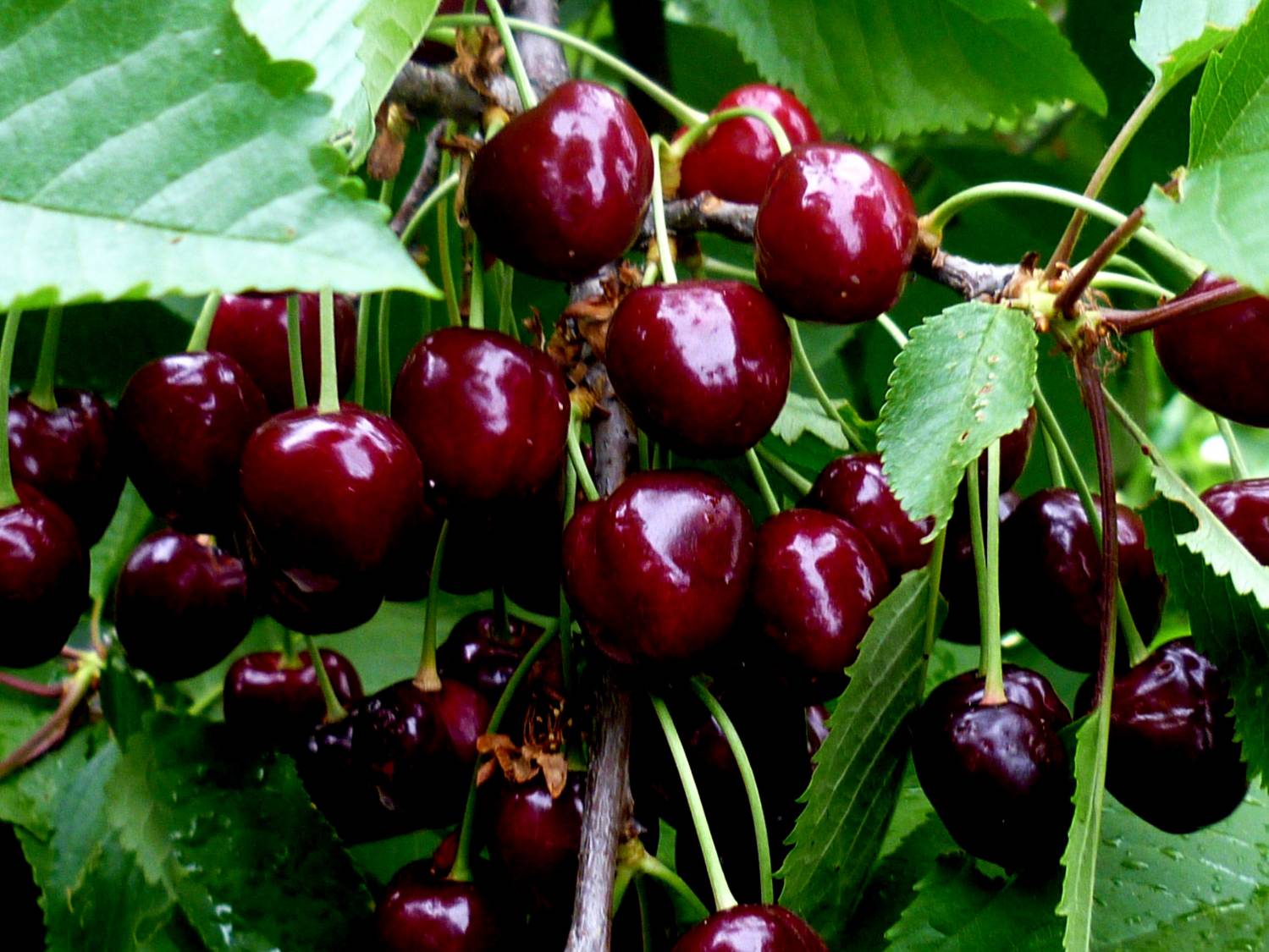Pear Forest beauty fully lives up to its name. Fruit of the correct shape with a red barrel, uniform texture and honey taste has long won popularity among many gardeners and summer residents. Interestingly, the variety is not the result of selection, while it has existed for over 200 years.
Content
History of the pear variety Forest beauty
It all started with the curiosity of researchers who, while exploring the remote places of Europe at the beginning of the 19th century, wandered into the forests of Chatillon in eastern Flanders, today's Belgium. Having discovered a tall, spreading tree and tasted its fruits, the travelers experienced true delight.
History has not preserved their names for us, nor the further sequence of events in the cultivation of a forest tree. The only known fact is that in 1906 the Fruit-Growing Society in St. Petersburg, under the leadership of the botanist Adam Grebnitsky, published the encyclopedic Atlas of fruits with tables and images. Two thick volumes included a complete collection of the best apples, pears and stone fruit crops of the Russian Empire. One of the places of honor in it belonged to the Forest Beauty variety, first discovered and cultivated in Flanders around 1810. True, in the scientific works of the Belgian breeders, the pear went either under the name of Marie-Louise, then Alexandrina. Modern catalogs have already put a dot in the names: they rejected the fact of the full identity of Belgian pears with Forest Beauty and noted only their similarity.
There is no complete clarity about the name Butterwood, assigned to this variety by the famous breeder-pomologist Lev Simirenko. It is possible that this is the author's name of the Forest Beauty, but it does not pass through the catalogs of the Russian Federation.
Regions of growth of the Forest Beauty and its hybrids
A pear from Belgium has taken root in the Russian open spaces, and in the Central Asian republics, and in the Baltic States, and in Ukraine, and in Belarus. The climate turned out to be favorable throughout the Volga River, in the North Caucasus, the Kuban and even in the southern regions of Siberia.
On the basis of the Forest Beauty, geneticists of the 20th century have developed more than 30 new varieties by hybridization. Among the experimenting fruit and berry stations are Rossoshanskaya, Nizhnevolzhskaya, Krasnoyarskaya and others. Of the most famous hybrids, the following can be noted:
- Small - the product of crossing with the Ussuriyskaya 212 pear.Designed for cultivation in Khakassia, as well as in Western and Eastern Siberia. Approved for breeding since 1993.
- Marble (Dessertnaya Rossoshanskaya) - a hybrid with the Bere winter Michurina variety. The culture has been widespread in the Central Black Earth District since 1965.
- Dubovskaya early, born as a result of crossing with Williams pear. Since 1989, the variety has been performing well in the Nizhnevolzhsky region.
- Clapp's favorite is a variety from the American originators, obtained from free pollination with Forest Beauty. Zoned for the Caucasian climate and for the Northwestern District in 1947.
Photo gallery: hybrids based on the Forest Beauty
- Small - the product of crossing of the Forest Beauty with the Ussuriyskaya pear 212
- Marble - a hybrid of the Forest Beauty with the Bere winter Michurina variety
- Early Dubovskaya was born as a result of crossing the Forest Beauty with Williams pear
- Pear Clapp's Favorite - a variety from the American originators, obtained from free pollination with Forest Beauty
Description and characteristics of the variety
The Forest Beauty tree is considered patient, fast-growing and frost-resistant.
At moderate winter temperatures, the culture does not freeze out and in spring it gathers color together. But one feature is universally noted: the tree requires a pollinator, which can be another variety of pears. It was experimentally found that the Forest Beauty blooms and bears fruit better in the company of varieties such as Williams or Limonka. Pollinating trees are planted in close proximity to the original variety, but no further than 30 m from it. One specimen is enough for a garden of 6-7 trees.
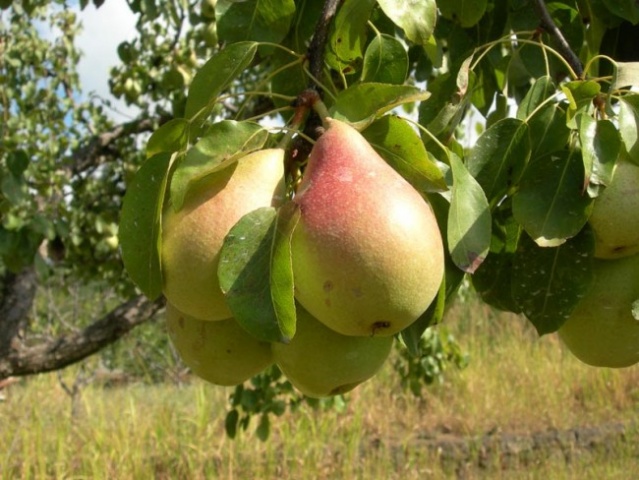
The forest beauty needs a pollinator, which can be another variety of pears, for example, Williams or Limonka
Isolation plantings are also possible - then the calculation falls on the self-fertility of the culture. The harvest under such conditions will be, but much less.
Table: characteristics and description of the variety Forest Beauty
| Appointment | Early autumn variety. Intended for fresh and processed consumption. Used for making jams, preserves, marmalades, compotes, wine. Suitable for drying |
| Wood | An adult tree reaches 5 m. Fruits begin to form at the age of 3-4 years. The foliage is of medium density. Fruit petioles are long and thin |
| Rootstock crops |
|
| Bloom | In the first half of May. Lasts about 2 weeks |
| Pollinating varieties | In addition to the above varieties, the following can be used as pollinators:
|
| Fruiting | Annual |
| Fruit, outside |
|
| Fruit, pulp | The pulp is white, but at full maturity it becomes slightly creamy. The taste is sweet, with sourness, very delicate and juicy. There is no cloying taste. There is an oily aftertaste. Sugar content is 8.5%, but this figure drops under cooler ripening conditions |
| Seeds | Large, hard, pointed at the top. Brown color |
| Harvest time | After August 20th. The fruits are harvested half-ripe, when the size has already reached its maximum, but the color remains green-yellow |
| Yield | With a planting scheme in one tree for 2-3 m2:
|
| Winter hardiness | Winter-hardy variety: withstands frosts down to -450FROM.But it is not zoned for cultivation in the regions of the Far North and the Far East |
| Disease resistance | Weak scab resistance. Fungicide treatment (Topsin M, Horus, Merpan) at the first signs of the disease is required |
| Transportability | Average |
| Keeping quality |
|
Advantages and disadvantages
As noted above, the variety is not capricious at all. It grows everywhere, except for the Far North and snowy regions of the Far East. That is why it is recommended for cultivation in summer cottages and farms, including those where there is not enough time for its processing. The forest beauty, as a true native of wild forests, will survive all adversity and lack of attention. And this is not the only "plus" of the plant. The main agrotechnical advantages of the variety are as follows:
- The variety is durable. The maturity of the tree is noted at 15–20 years, but it bears fruit even after 40–50 years. Specimens at the fruiting stage at the age of 80–90 years have been recorded.
- The variety bears fruit even on low-yielding soils. But with loose and nutritious soils, the harvest is richer.
- Despite its solid growth (up to 5 m), the root system of the tree is not considered powerful. Therefore, abundant watering is not required for the plant. And the adjacent buildings will not suffer in any way from the growth of roots or crown.
- Fruits of ideal shape and size have excellent taste - they can be used for harvesting and for drying, cut and whole.
- Violent flowering in the first half of May creates a special pleasure for aesthetes in the form of white-pink flowers.
- Due to the weather, color drops very rarely. The plant can withstand even a sharp drop in unstable spring temperatures.
Of the shortcomings, gardeners almost unanimously note the following positions:
- Low scab resistance. The tree needs to be treated with fungicides.
- Conditional self-fertility. The Forest Beauty needs a pollinator tree.
- The tendency to drop fruits throughout the entire period of their formation. The growth of carrion is especially intense under unfavorable weather conditions, in particular, during dry summers.
- Shrinking of fruits on mature trees.
- Short shelf life of the crop and average indicators for transportation.
- The inability to collect fruits without a stepladder or a special telescopic device for cutting them at a height.
Video: pear Forest beauty
Features of planting a tree
Forest Beauty, being unpretentious, will survive under any conditions. But nevertheless, the care and care will be fully appreciated. The steps for planting this variety are the same as those required for planting any other variety of pears. Preparation of a standard planting pit 2 weeks before planting, abundant watering of a young seedling, careful spreading of the roots when installed in the hole and mulching of the trunk circle zone are mandatory manipulations for all pears, including the Forest Beauty. However, there are some peculiarities.
The forest beauty does not need black soil or land that is highly enriched with peat. She will be able to grow even on loam, while giving abundant harvests. But the best solution would still be fertile soil, prepared in equal proportions from:
- humus;
- peat;
- sand.
From fertilizers, it is recommended to immediately apply:
- crystals of potassium salt (2 tbsp. l.);
- superphosphate powder (2 cups);
- dry wood ash (3-4 glasses).
The roots of the seedling should be pushed to further self-growth before being installed in the prepared hole. For this, it is recommended to soak them in a growth stimulant solution. The drug is diluted in concentration according to the manufacturer's instructions and the roots of the tree are dipped into the ground 6-10 hours before planting.
After the tree has been planted and the support peg is equipped, it is necessary to correctly arrange the space in the trunk circle. Mountains and hills should not be poured. Otherwise, during watering, all food, along with trace elements, will flow down the walls of this hill, not getting into the depths at all, to the roots. Around the trunk, you should get a flat circle of earth with several grooves, which, on the one hand, will drain excess water from the roots, and on the other hand, deliver food to them, like through a pipeline.
There is a non-standard approach to mulching the Forest Beauty's trunk circle. Of course, you can use traditional materials for these purposes:
- straw;
- peat;
- wood chips;
- bark;
- sawdust.
But live ground cover plants are also suitable for these purposes, such as:
- ageratums;
- sedums;
- alpine bells;
- arabis;
- small Turkish carnations and others.
Their roots are shallow and feed from the top layer of the soil, so they will not interfere with the roots of the pear, but will only help preserve moisture and protect the soil from overheating on sunny days.
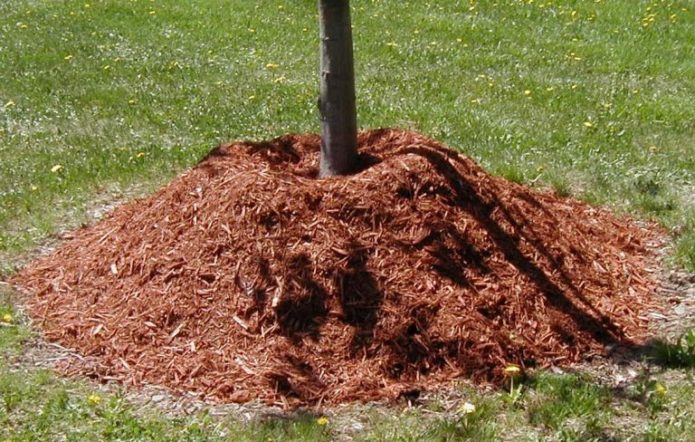
Such a landing is not considered correct: the roots can be opposed, and the slide itself will become a haven for harmful insects
Features of caring for a pear Forest beauty
The forest beauty will perfectly cope with many difficulties of life and without human attention. But then it will reduce the yield and turn into a wild game with small non-standard fruits. To prevent this from happening, it is important to perform some simple agronomic techniques.
Watering and feeding a young tree
Watering and fertilizing are important elements of pear care.
Watering is required during periods when the tree needs a lot of strength to grow and form ovaries:
- before flowering (early May);
- during the formation of ovaries (late May - early June);
- period of formation and growth of fruits (July).
Climatic and weather factors are also taken into account: in a dry summer, watering is the only salvation for the Forest Beauty. The volume of water depends on the growth and age of the pear.If 5 liters of water is enough for a 2-meter tree, then an adult 5-meter pear will gladly drink 15 liters.
The forest beauty responds well to sprinkling irrigation, when water flows directly to the crown through a diffuser. This technique will be a salvation for the plant on summer evenings.
As for the feeding, it must be remembered that any foliar and root feeding are carried out only after spilling with clean water. The fertilizer solution should be poured into the grooves, which are arranged in a circle at a distance of 15–20–30 cm from the trunk. A wet stem is not acceptable as it is an excellent breeding ground for microorganisms.
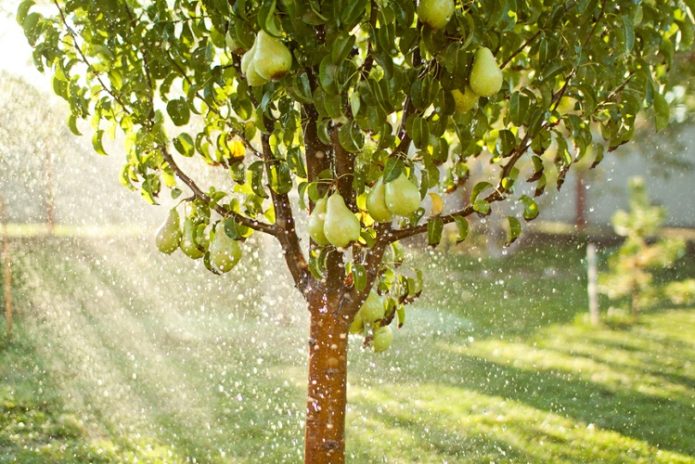
On summer evenings, it is possible to irrigate pears by sprinkling, when a stream of water, passing through a diffuser, rolls over the crown of a tree from top to bottom
During the formation of ovaries and fruits, foliar feeding is recommended. For this, phosphorus-potassium fertilizers are suitable, designed specifically for fruit trees. The concentration of the solution for foliar dressing should be 3-4 times less than when applied to the soil. For spraying the crown, a cloudy and dry day is chosen, as well as morning or evening hours. A weakly concentrated solution and clouds in the sky are a guarantee that delicate young leaves will easily tolerate the procedure without getting burned.
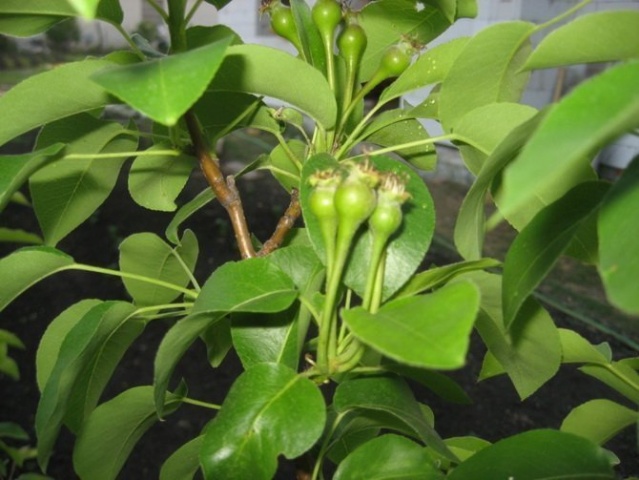
During the formation of ovaries and fruits, foliar feeding is recommended - phosphorus-potassium fertilizers designed specifically for fruit trees are suitable for it
Autumn feeding of a young tree is carried out in October to give it strength during hibernation and for a timely healthy awakening next spring. The main component of this top dressing should be potassium. It can be potassium humate or an autumn complex fertilizer for fruit trees. The introduction of wood ash into the space near the trunk circle is also encouraged.
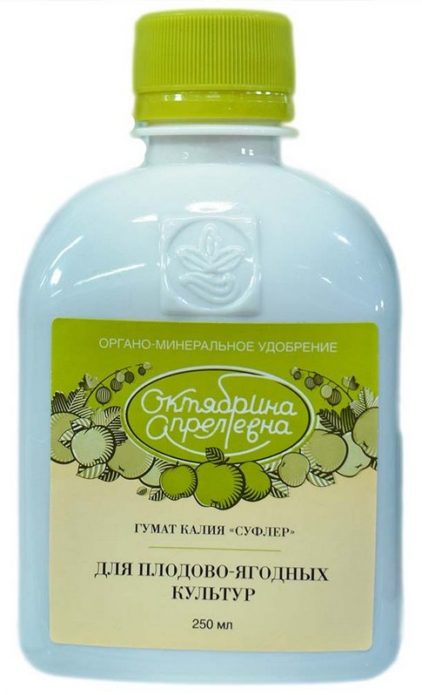
Autumn feeding of a young tree is carried out in October - at this stage, potash fertilizers are used, among which potassium humate is number one
Features of caring for an adult tree
Under favorable conditions, an adult tree of the Forest Beauty does not need scrupulous care. It grows on its own and bears fruit regularly. However, small recommendations do not hurt.
You can feed an adult tree with ready-made mixtures, which can always be purchased in specialized stores. The word "ready-made" means that all the constituent components are already balanced in a free-flowing powdery form, the consumer only needs to dilute the required amount of powder in accordance with the manufacturer's instructions.
Table: ready-made fertilizers for feeding pears Forest beauty
| Season | Fertilizer | Act |
| Early spring: before the leaves bloom | Complex fertilizers for fruit and berry crops:
| Complex fertilizers will help revitalize the roots after hibernation and fill all parts of the plant with the necessary nutrients |
| Spring: during flowering and ovary formation | Activin containing nitrogen, potassium, phosphorus | Promotes the strengthening of immunity, the synthesis of minerals necessary for full growth, an increase in the green mass of the plant |
|
| Increases resistance to diseases of fruit trees, contributes to the preservation of the ovary on the branches |
| Urea | It is used in early spring and early autumn to strengthen the plant and prevent diseases |
| Autumn: after shedding leaves | Plantafol Universal with a predominant content of potassium oxide and ammonium nitrate | Prepare the plant for winter, strengthen the immune system and overall tone |

To date, a whole line of complex fertilizers is produced - you can always choose the right one for the season and for field tasks
Harvesting
The forest beauty gives the harvest together, but:
- for 3-4 years of life, if it is grown from a healthy seedling;
- for the 4-5th year, if it is grafted on quince;
- for the 5-7th year, if it is grafted onto a wild pear.
You need to remove the fruits 6-10 days before full maturity. Otherwise, the entire crop risks ending up on the ground in the form of a carrion. The fruits are picked and placed in a cool, dark place for ripening, where they reach full ripeness. The lower the storage temperature, the longer this maturity takes. But the temperature limit should not fall below -20FROM.
It is recommended to store pears in a dry place protected from light and drafts. These can be cardboard boxes or wooden boxes with sawdust in a dry basement, closet or other special place. Individual paper wrapping for each fruit will extend the shelf life. And, on the contrary, iron boxes with rust stains will not only shorten the shelf life, but also give the fruit a metallic taste.
Pruning and shaping the crown
Formative pruning is necessary for the Forest Beauty every year:
- In the spring, after the first year of life, it is important to shorten the central trunk, leaving its length at the level of 50-60 cm from the ground. This will contribute to the formation of a standard tree with one main stem and the subsequent formation of side trunks, from which the rest of the crown will go up.
- Then it is necessary to make the formation of lateral support branches, which run at an angle of 450 to the central trunk. They are cut to a length of 20 cm. By autumn, these branches are overgrown with additional shoots - they need to be cut to the level of one bud.
- In subsequent years, it is necessary to lay the upper tier of the branches. Shoots on the supporting lateral branches are removed, leaving 3 buds on each. All new processes emanating from the central trunk, except for the supporting 4–5 branches, are removed. The formation of the crown in this way is of the fan type.
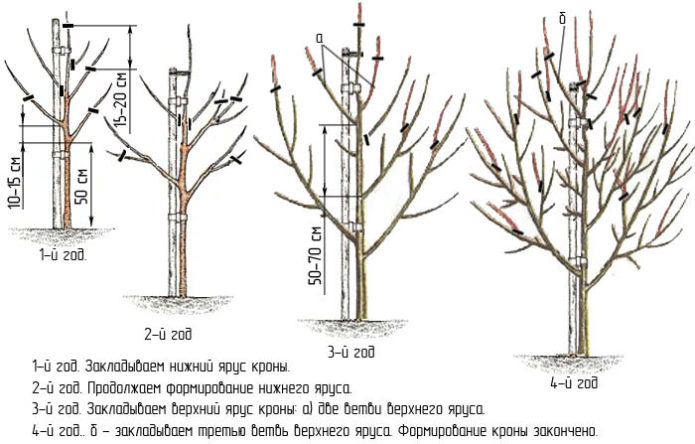
The crown of a pear is formed over 4 years: competent pruning will help create an efficiently fruiting standard tree
Rejuvenating pruning on the Forest Beauty is carried out no earlier than after 10 years of intense fruiting. Skeletal and stem branches, which for some reason have weakened and do not give a stable harvest, are removed.
Sanitary pruning of shriveled, diseased, damaged branches is carried out twice a year, in accordance with generally accepted pruning rules for pears. You should not neglect it, since it is the key to the health of the Forest Beauty and protection from scab.
Completion of the growing season
Even the coldest winters are not terrible for the Forest Beauty. But, nevertheless, work on preparing for the winter for the tree is being carried out. They are designed to give additional protection to the trunk and root system from frost, to save the plant until it awakens again next spring, to protect the bark from rodents and the first scorching rays of the spring sun.
Preparing for winter includes:
- Mulching the trunk circle with peat, humus, sawdust in a layer of 10–12 cm.
- Whitewashing the trunks to a height of 70–80 cm above ground level with a lime solution (2 kg of lime and 1.5 kg of clay per 10 liters of water).
- Covering the trunks of young trees with straw or paper.
- After the fall of winter precipitation, the formation of a layer of snow around the trunk. At the same time, you do not need to make a bottomless snowdrift, which can contribute to the drying out of the roots in spring.
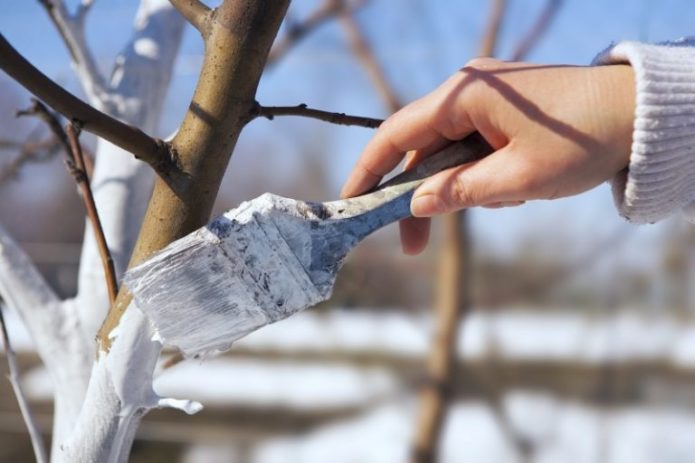
Whitewashing will give additional protection to the trunk and save it from frost, rodent bites and the first scorching rays of the spring sun
Reviews of gardeners about pear Forest beauty
And I really like this pear! I would not say that she is greatly amazed by something. Excellent frost resistance, excellent taste, as for a summer pear. And the presentation is good! Vaccinated on a wild pear.
The forest beauty froze out in the first severe winter. They bent there from -45C. We froze out at -36C. Moreover, it was grafted into the crown of a frost-resistant pear.
Of the two trees of the Forest Beauty, one has so far been left on the site. The tree is old, every year the pears were picked unripe. They lie down a little - very tasty, juicy. If left to full maturity, then the middle rots, the fruits crumble. Scab mainly affects the leaves, the fruits are insignificant. Frequent treatments are needed.
The tree of the Forest Beauty was planted by my grandfather. The tree is big. Fruits on older trees are smaller. There are fruits affected by scab, but not all. When the fruits are fully ripe, they are yellow with a red tan, but they are already pouring out and then a sourdough is obtained. Such, even if plucked carefully from a tree, no one eats. We tear off when still greenish. Then they are juicy, tasty. The only bad thing is that they do not lie, if put in boxes. As for the scab: if it grows in an open, well-ventilated place without thickening and there are no trees nearby, then not everything is so bad with scab.
The forest beauty is unpretentious to growing conditions, but will respond to care with a plentiful and high-quality harvest. Despite some disadvantages, the variety is attractive and will certainly appeal to gardeners who planted it in their area.

